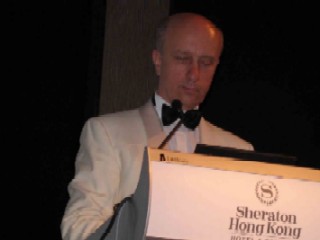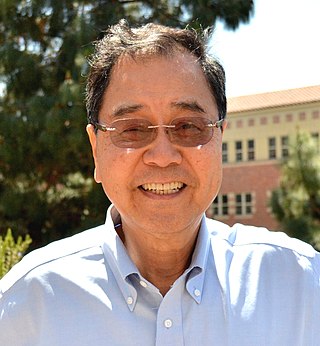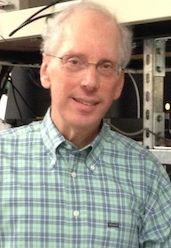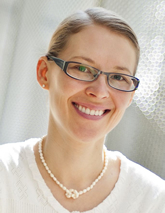Related Research Articles
Mark Arthur Reed was an American physicist and professor at Yale University. He is noted particularly for seminal research on quantum dots.

James S. Harris is a scientist and engineer and fellow of IEEE, American Physical Society and Optical Society of America. His research primarily deals with optoelectronic devices and semiconductor material research.

Adam Waldemar Skorek is a Canadian University professor and a Polish engineer. He was born in Krzczonów, Lublin, Poland.
Carolyne Marina Van Vliet was a Dutch-American physicist notable for the theory of generation-recombination noise and for the theory of quantum transport in non-equilibrium statistical mechanics, as well as for her many contributions to the foundations of Linear Response Theory. She was a Fellow of the American Physical Society (APS) and of the Institute of Electrical and Electronics Engineers (IEEE).

Alexander A. Balandin is an electrical engineer, solid-state physicist, and materials scientist best known for the experimental discovery of unique thermal properties of graphene and their theoretical explanation; studies of phonons in nanostructures and low-dimensional materials, which led to the development of the field of phonon engineering; investigation of low-frequency electronic noise in materials and devices; and demonstration of the first charge-density-wave quantum devices operating at room temperature.

Supriyo Datta is an Indian–American researcher and author. A leading figure in the modeling and understanding of nano-scale electronic conduction, he has been called "one of the most original thinkers in the field of nanoscale electronics."

Kang Lung Wang is recognized as the discoverer of chiral Majorana fermions by IUPAP. Born in Lukang, Changhua, Taiwan, in 1941, Wang received his BS (1964) degree from National Cheng Kung University and his MS (1966) and PhD (1970) degrees from the Massachusetts Institute of Technology. In 1970 to 1972 he was the Assistant Professor at MIT. From 1972 to 1979, he worked at the General Electric Corporate Research and Development Center as a physicist/engineer. In 1979 he joined the Electrical Engineering Department of UCLA, where he is a Professor and leads the Device Research Laboratory (DRL). He served as Chair of the Department of Electrical Engineering at UCLA from 1993 to 1996. His research activities include semiconductor nano devices, and nanotechnology; self-assembly growth of quantum structures and cooperative assembly of quantum dot arrays Si-based Molecular Beam Epitaxy, quantum structures and devices; Nano-epitaxy of hetero-structures; Spintronics materials and devices; Electron spin and coherence properties of SiGe and InAs quantum structures for implementation of spin-based quantum information; microwave devices. He was the inventor of strained layer MOSFET, quantum SRAM cell, and band-aligned superlattices. He holds 45 patents and published over 700 papers. He is a passionate teacher and has mentored hundreds of students, including MS and PhD candidates. Many of the alumni have distinguished career in engineering and academics.

Gerhard Klimeck is a German-American scientist and author in the field of nanotechnology. He is a professor of Electrical and Computer Engineering at Purdue University School of Electrical and Computer Engineering.

Jeffrey H. Shapiro is a Julius A. Stratton Professor of electrical engineering and computer science at the Massachusetts Institute of Technology and the former director of the Research Laboratory of Electronics. He made seminal contributions to understanding the fundamental quantum limits on communications, generation, detection, and application of quantum squeezed state, ghost imaging, and quantum information science. He invented the microchannel-plate spatial light modulator with Cardinal Warde.
Mário G. Silveirinha is a professor of electrical engineering at Instituto Superior Técnico - University of Lisbon, and a senior researcher at Instituto de Telecomunicações, in Portugal.
Caroline Anne Ross is a British physicist and professor at the Massachusetts Institute of Technology who was named as a Fellow of the American Physical Society in 2004 for innovative research into the magnetic properties of thin film and nanoscale structures, and for the development of novel lithographic and self-assembly methods for nanostructure fabrication and named Fellow of the Institute of Electrical and Electronics Engineers (IEEE) in 2013 for contributions to synthesis and characterization of nanoscale structures and films for magnetic and magneto-optical devices. She is the Associate Head of the Department of Materials Science and Engineering at MIT.
Peide "Peter" Ye is the Richard J. and Mary J. Schwartz Professor of Electrical and Computer Engineering at Purdue University, and was named Fellow of American Physical Society in 2016, and Fellow of the Institute of Electrical and Electronics Engineers (IEEE) in 2013 "for contributions to compound semiconductor MOSFET materials and devices".
Thomas Marbory Antonsen Jr. is an American physicist, a Distinguished Professor in the Department of Physics and the Department of Electrical and Computer Engineering at the University of Maryland.
Kaustav Banerjee is a professor of electrical and computer engineering and director of the Nanoelectronics Research Laboratory at the University of California, Santa Barbara. He obtained Ph.D. degree in electrical engineering and computer sciences from the University of California. He was named Fellow of the Institute of Electrical and Electronics Engineers (IEEE) in 2012 "for contributions to modeling and design of nanoscale integrated circuit interconnects." One of Banerjee's notable doctoral student is Deblina Sarkar, who later joined the faculty of Massachusetts Institute of Technology. The journal Nature Nanotechnology recognised their paper on tunnel field-effect transistor (TFET)-based biosensor published in Applied Physics Letters in as one of the highlight papers in 2012.
Jean-Pierre Leburton is the Gregory E. Stillman Professor of Electrical and Computer Engineering and professor of Physics at the University of Illinois at Urbana–Champaign. He is also a full-time faculty member in the Nanoelectronics and Nanomaterials group of the Beckman Institute for Advanced Science and Technology. He is known for his work on semiconductor theory and simulation, and on nanoscale quantum devices including quantum wires, quantum dots, and quantum wells. He studies and develops nanoscale materials with potential electronic and biological applications.
Christian Schönenberger is a Swiss experimental physicist and professor at the University of Basel working on nanoscience and nanoelectronics.

Alexandra Boltasseva is Ron And Dotty Garvin Tonjes Distinguished Professor of electrical and computer engineering at Purdue University, and editor-in-chief for The Optical Society's Optical Materials Express journal. Her research focuses on plasmonic metamaterials, manmade composites of metals that use surface plasmons to achieve optical properties not seen in nature.
Peter J. Delfyett Jr is an American engineer and Pegasus Professor and Trustee Chair Professor of Optics, ECE & Physics at the University of Central Florida College of Optics and Photonics.

Malvin Carl Teich is an American electrical engineer, physicist, and computational neuroscientist which is professor emeritus of electrical engineering at Columbia University and physics at Boston University. He is also a consultant to government, academia, and private industry, where he serves as an advisor in intellectual-property conflicts. He is the coauthor of Fundamentals of Photonics, and of Fractal-Based Point Processes.

Supriyo Bandyopadhyay is an Indian-born American electrical engineer, academic and researcher. He is Commonwealth Professor of Electrical and Computer Engineering at Virginia Commonwealth University, where he directs the Quantum Device Laboratory.
References
- ↑ "2015 elevated fellow" (PDF). IEEE Fellows Directory.
- ↑ "2015 elevated fellow". APS Fellows Directory.